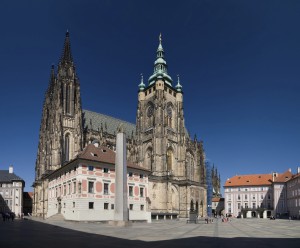St. Vitus Cathedral
By Erin Naillon
St. Vitus’ Cathedral towers regally over the other buildings of Prague Castle. This fairytale cathedral, the largest in the Czech Republic, was centuries in the building – as a matter of fact, ten centuries.
St. Vitus’ Arm
The foundations for St. Vitus’ Cathedral were laid in the tenth century. Wenceslas I, Duke of Bohemia, had obtained St. Vitus’ arm and wanted to build a church to hold the relic. The Romanesque rotunda was built circa A.D. 925, but the ill-fated Wenceslas was hacked to death only a few years later, putting an end to any plans he may have had to expand the church.
By 1060, the number of worshippers had exceeded the available space in the church. It was then made into a basilica, which included the part of the rotunda containing the tomb of Wenceslas, by now a saint. This church served the needs of the citizens for almost 300 years.
 French Gothic Style
French Gothic Style
In 1344, King Charles IV and Archbishop Arnost of Pardubice, among others, decided to turn the church into a cathedral. On November 21 of that year, the first stone was laid to make St. Vitus’ Cathedral the remarkable building it is today. The basic design was provided by French architect Matthias of Arras in the French Gothic style. Eight years later, with the cathedral still under construction, Matthias died. The reins were then taken by 23-year-old Czech architect Petr Parleř, later the designer of the Charles Bridge. Parleř oversaw the construction of all Matthias’ plans, then went in his own direction. Formerly a sculptor, Parleř designed the Cathedral more as a sculpture than as a building. His plans were so elaborate, and his additional work apart from the Cathedral so time-consuming, that Parleř himself died before he could see all his plans brought to fruition. Fittingly, he was buried in the Cathedral; his sons Wenzel and Johannes continued the construction.
Hussite Wars
Sadly for St. Vitus’ Cathedral, the 15th century brought the Hussite Wars, which ravaged the country and put a halt to the construction, followed by a severe fire in 1541. The Cathedral remained only partially finished for the next 300 years.
Reconstruction in the 19th Century
In 1844, canon Vácslav Pešina and architect Josef Kranner presented their ideas for restoring and completing St. Vitus’ Cathedral. For more than twenty years afterward, the Cathedral was gradually cleaned, repaired, and restored. Kranner died in 1873, and his work was taken over by Josef Mocker.
St. Vitus’ Cathedral in the 20th Century
Finally, in the 20th century, St. Vitus’ Cathedral stood triumphant, having survived the centuries relatively unscathed. Popular Czech Art Nouveau artist Alfons Mucha designed a stained-glass window that still glows with the sunlight; the other windows, including the magnificent round window above the front door, remain intact. More recently, a medieval mosaic on the outside wall of the Cathedral, showing Biblical scenes, was painstakingly restored.
St. Vitus’ Cathedral sits firmly in the center of the Prague Castle complex. The best time to visit is in the summer when the strong sunlight illuminates the interior through the multicolored stained glass.



